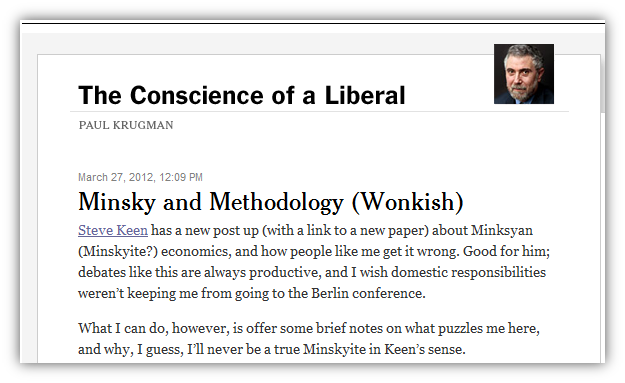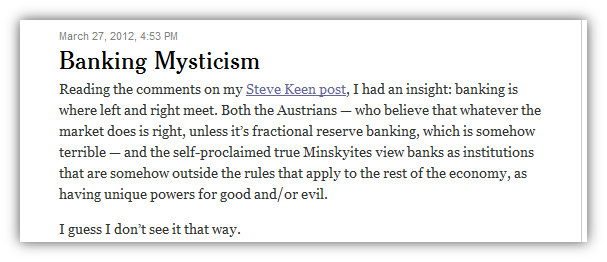Generatywna sztuczna inteligencja a wzrost gospodarczy
Kategoria: Trendy gospodarcze
Paul Krugman has just commented (twice) on my most recent blog about my paper for INET. In one sense, I’m delighted. The Neoclassical Establishment (yes Paul, you’re part of the Establishment) has ignored non-Neoclassical researchers like me for decades, so it’s good to see engagement rather than wilful (or more probably blind) ignorance of alternative approaches.
Figure 1: Krugman’s first piece
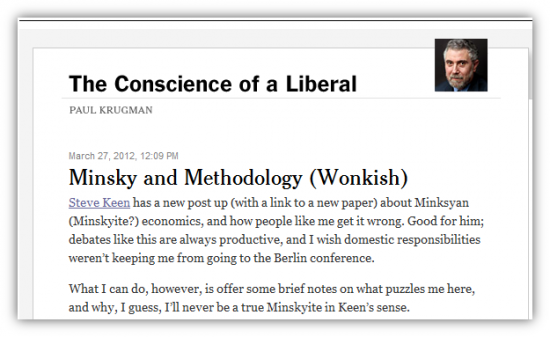
There is a bizarre asymmetry in economics: critics of Neoclassical economics like myself read Neoclassical literature avidly, no because we agree with it—far from it—but because we feel obliged to understand why they hold to their counterfactual views on the economy.
Most Neoclassical economists, on the other hand, don’t even bother to consider critics within their own ranks—let alone critics from without. So to have a paper referred to is definitely a plus.
In another sense, I’m appalled, because Krugman’s comments put on display that very ignorance of Neoclassical literature—let alone of alternative economic thought.
For instance, Paul refers to many of the propositions in my blog (it’s clear that he hadn’t read the paper on which it is based) as “assertions about what is crucial, without much explanation of why these things are crucial.”
One of these “assertions” is the key role of the change in debt—rather than saving out of current income—in financing investment.
Well Paul, in that paper you will find references to the extensive theoretical and empirical literature from which that assertion was derived. I could start with non-Neoclassical authors like Schumpeter, but let’s lead with someone from within The Citadel (as Alan Kirman once called the Neoclassical orthodoxy: Alan Kirman, 1989, p. 126): Eugene Fama. The “assertion” that the change in debt was the main source of funding for investment was confirmed by Fama and French in a pair of empirical papers:
The source of financing most correlated with investment is long term debt. The correlation between I and dLTD is 0.79… These correlations confirm the impression … that debt plays a key role in accommodating year-by-year variation in investment.” (Eugene F. Fama and Kenneth R. French, 1999, p. 1954)
“Debt seems to be the residual variable in financing decisions. Investment increases debt, and higher earnings tend to reduce debt.” (in an unpublished draft of the same paper).
Or consider Alan Holmes’s crucial paper in 1969, in which he fought an unsuccessful campaign against the later experiment in Monetarism (far from being a “strict Monetarist”, as Paul jibes at one point, I and my Post-Keynesian colleagues and forebears take money seriously while simultaneously being trenchant critics of Friedman’s simplistic Monetarism—see for example Nicholas Kaldor, 1982). Holmes, then Senior Vice-President of the New York Federal Reserve, noted that the key Monetarist policy prescription of regulating the economy by “a regular injection of reserves” was based on “a naïve assumption” about the nature of the money creation process:
The idea of a regular injection of reserves—in some approaches at least—also suffers from a naïve assumption that the banking system only expands loans after the System (or market factors) have put reserves in the banking system. In the real world, banks extend credit, creating deposits in the process, and look for the reserves later. (Alan R. Holmes, 1969, p. 73)
Holmes would turn in his grave at Krugman’s naïve assertion, half a century later, that banks need deposits before they can lend:
If I decide to cut back on my spending and stash the funds in a bank, which lends them out to someone else, this doesn’t have to represent a net increase in demand. (Paul Krugman, 2012)
As Randy Wray observed, that is “the description of a loan shark, not a bank”—or of a hypothetical world in which banks need deposits before they can lend. In the real world, as Holmes points out above, bank lending creates deposits. That’s why banks matter in macroeconomics, and it’s not “Banking Mysticism” to point this out: it is “Banking Armchair Theorism” to ignore them in macroeconomics.
Neoclassical economists have ignored this point for decades, which is why you have to look to the non-Neoclassical literature to truly understand money creation and the crucial role of banks. Schumpeter put it clearly during the last Depression: he described the view that Krugman puts today, that investment (which is what the most important class of borrowers do) is financed by savings, as “not obviously absurd”, but clearly secondary to the main way that investment was financed, by the “creation of purchasing power by banks … out of nothing“. This is not “Banking Mysticism”: this is double-entry bookkeeping:
Even though the conventional answer to our question is not obviously absurd, yet there is another method of obtaining money for this purpose, which … does not presuppose the existence of accumulated results of previous development, and hence may be considered as the only one which is available in strict logic.This method of obtaining money is the creation of purchasing power by banks… It is always a question, not of transforming purchasing power which already exists in someone’s possession, but of the creation of new purchasing power out of nothing. (Joseph Alois Schumpeter, 1934, p. 73)
Figure 2: Krugman’s second piece
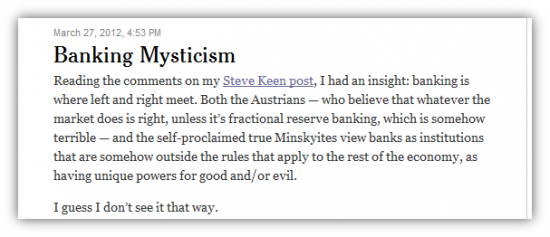
Why does it matter that “once you include banks, lending increases the money supply”? Simply, because the endogenous increase in the stock of money caused by the banking sector creating new money is a far larger determinant of changes in aggregate demand than changes in the velocity of an unchanging stock of money. And in reverse, the reduction in demand caused by borrowers repaying debt rather than spending is the cause of the downturn we are now in—and of the Great Depression too.
Figure 3 shows the ratios of private and public debt to GDP in America from 1920 till now. Non-neoclassical economists like myself, Michael Hudson, Ann Pettifor, the late Wynne Godley, Randy Wray and many others (see Dirk J Bezemer, 2009, andEdward Fullbrook, 2010 for fuller lists of those who warned of this crisis before it happened–including of course Nouriel Roubini, Dean Baker, Robert Shiller, and Peter Schiff) were shouting that the post-1993 explosion in private debt was unsustainable, and would necessarily lead to a crisis when its rate of growth slowed (let alone turned negative), for years before the crisis began (my first academic warning of the dangers of rising private debt is shown as SK1, and my first public warning that a crisis was imminent is shown as SK2 on Figure 3). We were ignored, in large part because only Neoclassical economists like Krugman, Bernanke and Greenspan had the ear of the public and politicians.
Now the crisis is the defining economic event of our times, and years after it began, the only period to which the recent boom and bust in the private debt to GDP ratio can be compared is the Great Depression.
Figure 3: Aggregate Private and Public Debt
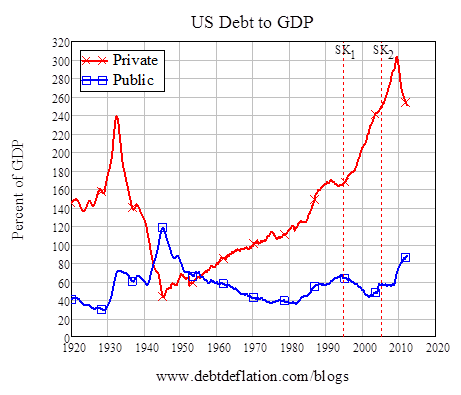
Yet Neoclassical economists like Krugman continue to assert that the aggregate level of private debt, and changes in that level, are macroeconomically irrelevant, when even casual empiricism implies that changes in the aggregate level of private debt are associated with Depressions.
So while I welcome any Neoclassical economist at the forthcoming INET conference taking up Krugman’s call (“I hope someone in Berlin presses Keen on all this”), in reality Paul, empirically oriented non-Neoclassical economists like myself are the ones challenging the unsupported assertions of Neoclassical economics—not the other way round.
Bezemer, Dirk J. 2009. “”No One Saw This Coming”: Understanding Financial Crisis through Accounting Models,” Groningen, The Netherlands: Faculty of Economics University of Groningen,
Fama, Eugene F. and Kenneth R. French. 1999. “The Corporate Cost of Capital and the Return on Corporate Investment.” Journal of Finance, 54(6), 1939-67.
Fullbrook, Edward. 2010. “Keen, Roubini and Baker Win Revere Award for Economics,” E. Fullbrook, Real World Economics Review Blog. New York: Real World Economics Review,
Holmes, Alan R. 1969. “Operational Constraints on the Stabilization of Money Supply Growth,” F. E. Morris, Controlling Monetary Aggregates. Nantucket Island: The Federal Reserve Bank of Boston, 65-77.
Kaldor, Nicholas. 1982. The Scourge of Monetarism. Oxford: Oxford University Press.
Kirman, Alan. 1989. “The Intrinsic Limits of Modern Economic Theory: The Emperor Has No Clothes.” Economic Journal, 99(395), 126-39.
Krugman, Paul. 2012. “Minsky and Methodology (Wonkish),” The Conscience of a Liberal. New York: New York Times,
Schumpeter, Joseph Alois. 1934. The Theory of Economic Development : An Inquiry into Profits, Capital, Credit, Interest and the Business Cycle. Cambridge, Massachusetts: Harvard University Press.
